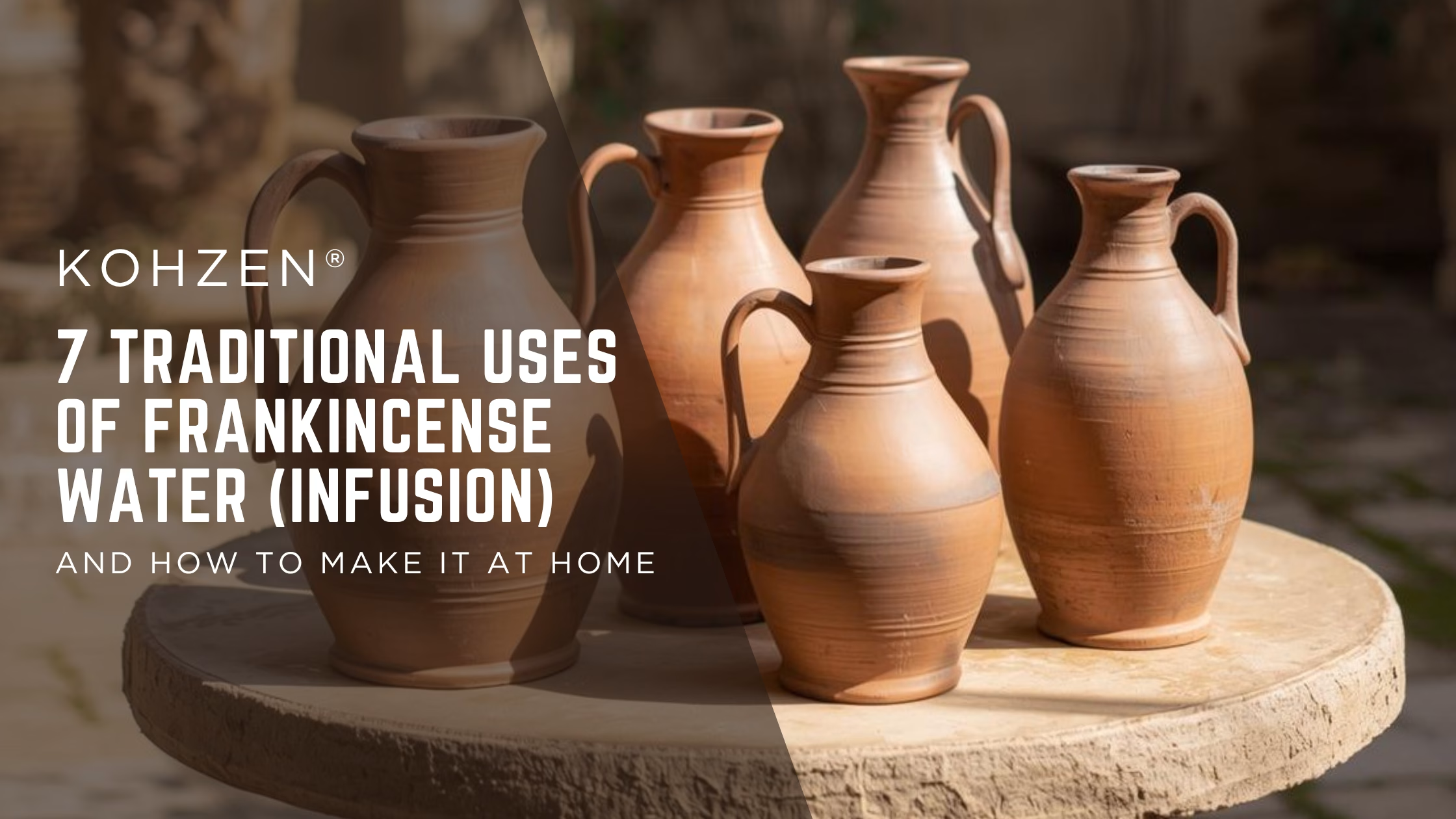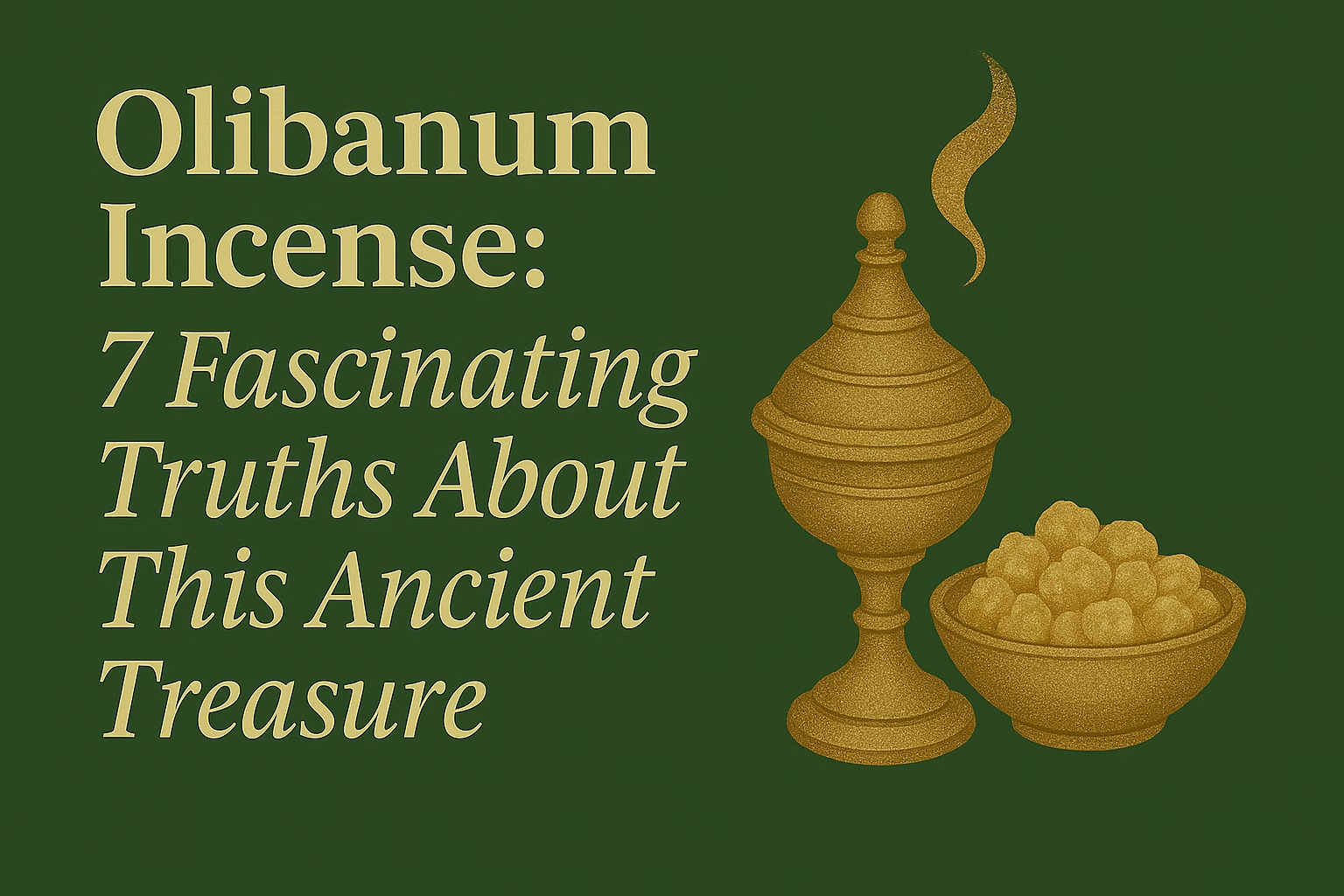Frankincense water is a simple, traditional infusion made by steeping Boswellia sacra (Hojari) resin—often called “frankincense tears”—in hot water. Unlike essential oils or distilled products, this is a gentle resin tea, valued for its aroma and clarity rather than its strength. For centuries, it has been part of daily life and trade in regions such as Oman, Arabia, the Levant, Cyprus, India, and Egypt, where people prepared it as a refreshing drink, a household ritual, or a cultural offering.
Historical records even trace its presence back to ancient Egypt, where frankincense held a place of honor in both sacred and everyday life. In Ayurvedic tradition as well, resin infusions were woven into practices of balance and well-being. Across these cultures, frankincense water has been seen less as a cure and more as a way to connect body, mind, and spirit through a natural, calming ritual. (For more on frankincense itself, see our Ultimate Guide to Frankincense and Kohzen About page.)
What Is Frankincense Water (Infusion)?
Frankincense water – sometimes called a frankincense infusion – is a simple and traditional way of enjoying the fragrant resin of the Boswellia tree. Small pieces of resin, often referred to as “tears,” are placed in warm water and left to steep. As the resin softens, the water takes on a cloudy, milky appearance and a gentle aroma. This is not an essential oil or distilled product, but more like a light herbal tea.
For centuries, frankincense has held a place of reverence in many cultures – from temples to traditional households. In various parts of the world, people have sipped infusions made from the resin, often as part of rituals of relaxation, hospitality, or spiritual practice. High-quality resin, such as the pale “Hojari” variety from Oman, has long been prized for its purity, delicate taste, and uplifting fragrance.
Today, many continue this old custom, not for medical treatment, but as a way to connect with tradition and enjoy the soothing qualities of a warm, aromatic drink. Frankincense water is often appreciated as a calming, grounding ritual – something to sip slowly, much like tea – that carries with it centuries of cultural heritage.
7 Traditional Uses of Frankincense Water
For centuries, people across different cultures have turned to frankincense water as a gentle, everyday ritual. Whether sipped slowly, used as a rinse, or applied in simple home remedies, this aromatic infusion has long been cherished for the sense of balance and comfort it brings. Below are some of the traditional ways it has been enjoyed:
- Easing Aches and Discomfort: In folk practices, frankincense resin has often been prepared in water to help ease stiffness, sore joints, or general body tension. Many people would drink a small cup daily, believing it supported movement and comfort as they went about their day.
- Supporting Digestion: Frankincense water has been used as a calming drink after meals, thought to help settle the stomach and soothe the digestive system. Traditional households sometimes relied on it to bring relief after heavy or rich foods.
- Comforting the Breath: In West Asian and African traditions, frankincense steam and water were valued for easing the chest and opening the breath. Families would sip the infusion or breathe in its fragrant steam when dealing with seasonal changes, coughs, or congestion.
- Oral Care Rituals: In many places, cooled frankincense water was used as a gentle rinse or gargle to freshen the breath and soothe the gums. This practice continues today as a natural addition to oral care, complementing—but never replacing—modern dental hygiene.
- Skin and Wound Care: Applying frankincense water to the skin is a long-standing practice. Traditionally, it was dabbed on minor cuts, blemishes, or areas of irritation, with the belief that it could help calm and purify the skin. A cool compress soaked in frankincense water was also a common way to refresh tired or sun-warmed skin.
- Relaxation and Mindfulness: Beyond its practical uses, frankincense water has always been appreciated for the tranquility it brings. Drinking it slowly, especially in the evening, can serve as a grounding ritual—a moment of calm and reflection in a busy day.
- A Tonic for Vitality: Many cultures see frankincense water as a gentle tonic, believed to support overall well-being. Just as people turn to herbal teas for everyday nourishment, frankincense infusion is seen as a way to invite balance, clarity, and resilience into daily life.
By weaving frankincense water into a lifestyle—whether through a morning cup, a soothing rinse, or a quiet evening ritual—you connect with traditions that have spanned generations. At Kohzen, we source only the highest-grade frankincense to honour this heritage and bring its timeless benefits into modern living.
How to Make Frankincense Water at Home
Making frankincense water is easy and inexpensive. You don’t need special gear, just high-quality resin and clean water. Follow these simple steps using Kohzen Hojari frankincense tears:
Making frankincense water at home is simple and rewarding. You’ll need Kohzen Hojari frankincense resin and water.
- Gather ingredients: Use about 1 teaspoon of Hojari frankincense resin per 750–1,000 ml of water. One teaspoon is roughly 2–3 grams of resin. We recommend Kohzen’s light-coloured Hojari tears (Royal Green or Pure White grade) for the purest taste. Ensure your glass jar is clean; a 500–1000 ml jar or bottle works well.
- Add the resin: Place the measured frankincense tears into the jar. You can use them whole. If any pieces are very large, break them into smaller chunks so they infuse more fully. The resin will sink to the bottom.
- Pour hot water: Boil fresh water and let it cool for a minute to avoid cracking the jar. Carefully pour the water over the resin, filling the jar almost to the top. You’ll immediately see the water turn cloudy or milky as the resin releases its compounds. Do not fill completely; leave a little headspace to shake.
- Seal and steep: Screw on the lid and give the jar a gentle shake to mix the resin and water. Then set the jar aside. It should steep and cool naturally. For best results, leave the infusion at room temperature or in the fridge for about 8–12 hours (overnight is ideal). Longer steeping extracts more of the resin’s benefits. During this time, the water will gradually take on flavour and colour.
- Strain and serve: After steeping, pour out a glass (200–250 ml) of the infused water. (You can use a fine strainer or simply decant, since any floating bits are harmless.) The taste will be very mild – perhaps slightly piney, citrusy or resinous. Some people like to add a little honey or lemon for flavour. Drink in sips, as you would herbal tea, preferably on an empty stomach or between meals for best absorption.
- Reuse the resin: Don’t throw away the resin after one cup! You can refill the jar with fresh hot water and steep again 1–2 more times. The resin gradually softens with use. Eventually, you may even chew on the softened bits gently (they become more gelatinous) to get the very last of the boswellic acids. After 2–3 infusions, the resin will be fully spent and can be composted.
Following these steps lets you easily brew a personal supply of frankincense water. Store any unused infusion in the fridge and use within 24–48 hours. Always use clean containers to prevent contamination. (For extra convenience, you can prepare multiple jars and label them by date.)
Traditional Internal and Topical Uses of Frankincense Water
Frankincense water has been cherished for generations in many parts of the world, valued for both its refreshing taste and its versatile everyday uses. Below are some of the ways people traditionally enjoy it, both inside and out:
- As a Daily Drink: Many families sip a cup of frankincense water in the morning or evening as a simple wellness ritual. Some prefer it on an empty stomach, others throughout the day as a soothing, caffeine-free alternative to tea or coffee. Beyond hydration, this gentle practice is often seen as a way to bring clarity, calm, and balance to body and mind.
- As a Mouth Rinse: In some traditions, cooled frankincense water is swished in the mouth after brushing as a natural rinse. It is believed to freshen the breath, comfort the gums, and leave the mouth feeling clean. The practice is simple—swish, gargle, and spit—offering a natural complement to modern oral care.
- For Skin Care: Frankincense water has long been applied externally to refresh and soothe the skin. A cotton pad soaked in the cooled infusion can be used as a gentle toner for the face, or dabbed onto areas of redness, blemishes, or insect bites. In folk remedies, it was also used on small scrapes or irritations. As with all natural preparations, it’s wise to test a small patch first.
- As a Warm or Cool Compress: Soaking a cloth in warm frankincense water and placing it on tired muscles or stiff joints has been a traditional way to bring comfort and ease. In hot climates, cooled frankincense water has also been sprayed or applied to the skin to refresh and cool, especially after sun exposure.
- As Aromatic Steam: The rising fragrance of freshly prepared frankincense water has always been part of its charm. Inhaling the gentle vapors is thought to open the breath and quiet the mind. Leaning over the warm infusion with a towel draped over the head is an old household remedy for clearing the head and encouraging relaxation.
Used in these ways, frankincense water weaves into daily life as more than just a drink—it becomes a ritual of care and connection with tradition. Its effects are subtle, but many find that, over time, this ancient practice helps create moments of peace, comfort, and balance.
Safety and Precautions
Frankincense water is not a medicine or a treatment—it is a traditional beverage that has been enjoyed in different cultures for its fragrance, flavour, and place in daily rituals. It should never be viewed as a substitute for medical care or used to treat health conditions. Like any natural preparation, some people may find the taste strong or may prefer not to use it if they have sensitivities, especially on the skin. The best way to enjoy frankincense water is as part of a cultural or personal ritual, in moderation, and purely for its sensory and traditional value.
FAQs
Q: What is frankincense water?
A: Frankincense water is a traditional infusion made by soaking frankincense resin in water. It’s discussed in cultural contexts across parts of Asia and Africa.
Q: What are traditional, non-medical uses of frankincense water?
A: Frankincense water is used in cultural and mindful rituals such as welcoming guests, scent-based grounding, and seasonal practices. These are heritage uses, not for use in any medical contexts.
Q: How do you make frankincense water at home?
A: Frankincense water is usually made by soaking a few clean resin “tears” in hot water, then cooling and storing for several hours or overnight, then straining. Keep volumes small and freshly brew; this is the traditional way of making.
Q: How long does frankincense water keep?
A: Frankincense water is best used within 1–2 days; keep it covered in the fridge to maintain aroma.
Q: Is it safe to drink frankincense water?
A: Frankincense water appears in cultural practice and is typically sipped in small amounts, but it should not be treated as a remedy. When in doubt, avoid or seek professional guidance.
Summary: Key Takeaways
- Traditional infusion: Frankincense water is made by steeping Boswellia sacra resin in hot water, creating a fragrant, resin-based tea that has been enjoyed in traditional cultures for centuries. It is not an oil, extract, or medicine—just a simple preparation of resin and water.
- A sensory ritual: Families have long used it as a daily drink or shared it during special moments. Its aroma, taste, and gentle character make it a soothing part of cultural and personal rituals.
- Easy to prepare: Brew with 2–3 g high-quality Hojari frankincense per 750 ml water. Let it steep 8–12 hours, then drink plain or lightly sweetened. You can reuse the resin for multiple brews.
- Mindful Enjoyment: Because every person responds differently to natural substances, some may prefer smaller amounts or external use only. It’s best appreciated moderately and as a cultural practice rather than something taken in excess.
- Quality matters: The experience is only as good as the resin itself. Pure, high-grade Hojari frankincense creates the cleanest, most enjoyable infusion, while lesser-quality products may not carry the same fragrance or clarity.
Frankincense water is best seen as a way to connect with heritage, ritual, and the timeless pleasure of simple natural practices. It is not a drug, remedy, or substitute for professional care—just a gentle tradition to be enjoyed with mindfulness.
Ready to try making your own frankincense tea? Visit the KohzenOfficial Etsy shop to find our premium Hojari frankincense resin and begin brewing this ancient wellness infusion today. Prefer scent rituals instead? Learn to burn resin cleanly in How to Use Frankincense Resin Like a Pro.
Kohẓen Disclaimer:
The information provided on Kohzen.com and affiliated platforms is for educational purposes only and is not intended to substitute professional medical advice, diagnosis, or treatment.
While frankincense water (infusion) made with Boswellia sacra resin has a long tradition of use, its internal consumption may not be appropriate for everyone. We strongly recommend that you consult your doctor or qualified healthcare professional before ingesting frankincense water, especially if you:
- Are pregnant or breastfeeding
- Have a medical condition
- Take medications (including blood thinners or anti-inflammatories)
- Are considering giving it to children
Kohẓen (unlike other frankincense purveyors) does not claim that frankincense water treats, cures, or prevents any disease. Use is at the discretion and responsibility of the individual. If any adverse reaction occurs, discontinue use and seek medical attention.


